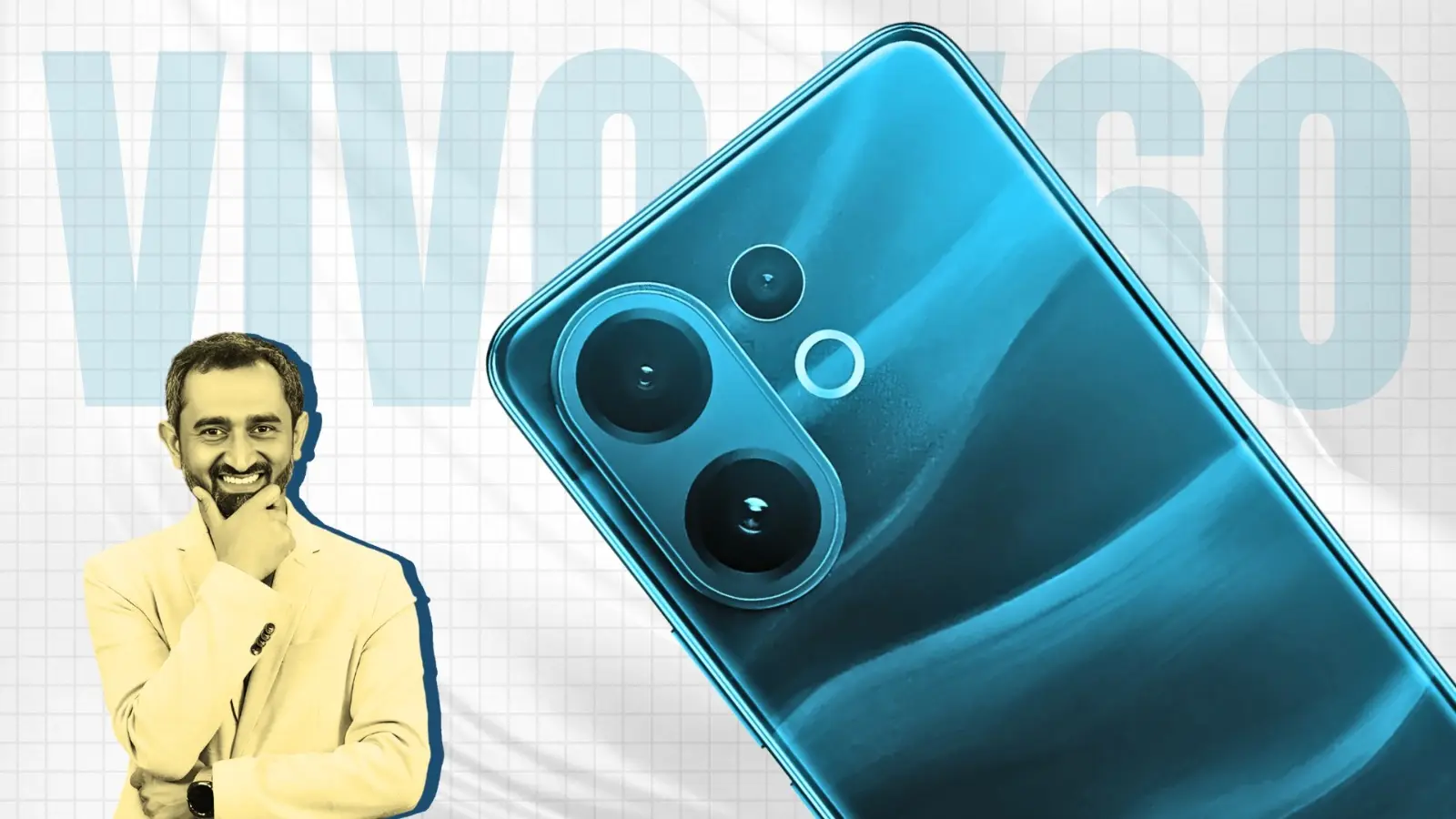Vivo V60 Review: Camera Phone That Nails the Basics
Story Highlights
The Vivo V60 focuses on being balanced and dependable while still carrying Vivo’s design charm. If you’re upgrading from a phone that’s two or three years old, maybe a V30, V40, or even a mid-range Samsung or OnePlus, the V60 will feel like a big jump.

The Vivo V60 feels like a good-looking reliable phone with a solid camera.
There's a rhythm to how smartphone brands evolve. Some focus on flagship specs, others push innovation across multiple fronts. Vivo found their lane early and perfected it: cameras that make you look great and designs that stand out. With this, the brand has mastered what its niche user base prioritises and it's worked brilliantly at least for the mid-tier V-series. These are not bare-bones budget phones, nor do they try to climb into the ultra-expensive flagship territory. They are meant to look premium, feel sleek and pack good cameras.
The Vivo V60 continues this philosophy. A slim body. A huge 6500mAh battery. IP68 and IP69 water resistance. A bright AMOLED screen. And a camera system co-engineered with ZEISS. On paper, this is not just another good-looking mid-ranger, it demands to be taken seriously. I’ve spent a few weeks living with it. Not just for testing, but as my main phone, and here’s what I feel about it.
Design and Build: When I first picked up the Vivo V60, honestly I was a little skeptical. I had been using the Vivo V200 FE for quite some time, and I liked its compact design. In fact, in terms of in-hand feel, I’d call it one of the best phones I used this year. So naturally, shifting to the V60, with its more typical and taller V-series size, felt a bit odd in the beginning. There was that hangover of the smaller, easier form factor. For the first few days, it didn’t click with me completely. But as I kept using it, I got comfortable. Vivo has always had a strong sense of aesthetics, and the same is the case with this phone.
Design-wise, it’s not drastically different from the V50. The overall vibe is quite similar. What is noticeable, though, is the camera module. The placement feels more like the X200 FE — or if you want to stretch it, it is like the iPhone 16. Which makes sense, because Vivo kind of borrowed that layout for the X200 FE in the first place. It’s simple and doesn’t look messy.
I got the Auspicious Gold variant. This is the glass-back model, and it looks classy in person. The colour is not over-the-top shiny gold but a softer, warmer shade. The glass back feels smooth and cool when you touch it. The phone is 7.65mm slim and weighs about 200g. For a device with a massive 6500mAh battery, the dimensions are impressive. In hand, it feels slimmer than you expect and doesn’t give you that bulky, brick-like vibe. The curved edges of the display also make it easier to grip. Compared to the compact V200 FE, yes, this one feels taller and wider, but after a week of use, it started to feel natural in the palm.
One big addition in design is the durability factor. The Vivo V60 comes with IP68 and IP69 ratings, which means dust-proofing, water resistance, and even the ability to handle high-pressure jets.
Display: The Vivo V60 comes with a 6.78-inch AMOLED panel which is curved slightly at the edges. The curved panels have an issue of the annoying “accidental touches” way but not here. It’s more of a gentle curve that looks premium without messing with usability. The resolution sits at 1.5K (2800 x 1260), slightly sharper than plain Full HD+.
It’s bright. Like, really bright. Vivo claims up to 5,000 nits local peak brightness and that’s not just marketing fluff. Under Delhi’s sun, the V60 stayed perfectly legible. Colors pop just enough without going overboard. The panel supports P3 wide color and 10-bit, reporting around 1.07 billion colors. The panel boasts a 120Hz refresh rate, which makes everything from scrolling through social media feeds to navigating the UI feel incredibly fluid and instantaneous.
Watching content is a treat. It supports HDR10+. So, you’ve got a display that’s ready to handle anything, from intense gaming sessions to streaming your favourite shows in the highest quality. Highlights are bright and punchy without blowing out details, making for a very immersive viewing experience. Bright areas like sunlight or fire pop without burning out. Shadows retain detail. Colours feel rich without looking fake.
The usability bits are thought through. Because the curve is gentle, there’s minimal color shift at extreme angles and no rainbow banding along the edges. The bezels are negligible and reasonably even. Protection is Schott Xensation Core glass. It won’t make the phone invincible (keys + quartz countertops still win), but it adds confidence against micro-scratches from dust and everyday grits.
Camera: Cameras have always been Vivo’s playground. This is their domain. The V60 carries forward this legacy with its ZEISS-tuned triple-camera system that looks solid. On the hardware side you get a 50MP main sensor with OIS, a 50MP telephoto with OIS along with 3x optical zoom, and an 8MP ultra-wide lens. Up front, there's a 50MP selfie camera.
I took the phone to a nearby park one morning, and it handled different textures really well. The old stone walls, tree bark, wet grass on the ground, everything looked natural and clear. Leaves didn’t look plasticky. Sky gradients were smooth. Shadows held detail without turning into black patches. Colours leaned slightly towards saturation, but not in a bad way. It’s the kind of tuning that makes photos pop on social media without heavy editing. Greens looked lively, reds stood out, and blues had depth. The dynamic range was solid. Even in tricky shots with bright sun and deep shadows, the V60 handled exposure well. For example, shooting a roadside tea stall at noon, the background sky didn’t blow out, and the shaded faces still had enough detail.
The 50MP telephoto lens with OIS is where the V60 adds a serious advantage over many rivals in its price band. At 3x optical zoom, shots are clean, sharp, and free from the softness you usually get with digital zoom. Portraits look excellent here. The compression effect at 3x gives faces a flattering shape, and the background blur feels natural.
I clicked a portrait of a friend. The details on the face were sharp, the edges were cut clean, and the bokeh in the background looked DSLR-like. Vivo’s portrait mode has always been strong, and with ZEISS tuning, it now feels more refined. Zooming further to 5x, the photos still hold up decently. At 10x digital, detail starts to drop, and you won’t want to use it much.
The 8MP ultra-wide is the weaker link here. In daylight, it’s fine. Colours stay consistent, distortion is minimal but details and sharpness are compromised. This is a lens you’ll use for landscapes or group shots in good light, but not much else.
Vivo’s low-light processing has improved in the last few years, and the V60 benefits from that. With OIS on both the main and telephoto lenses, handheld night shots come out sharper more often than not. The telephoto also holds up in night mode. At 3x, portraits under street lamps looked surprisingly usable. Background blur combined with the warm light made for atmospheric shots.
The V60 includes multiple ZEISS portrait styles such as Biotar, Planar, and Distagon. Each creates a slightly different bokeh effect. Vivo’s Wedding mode feels purpose-built for Indian ceremonies. It leans into warm golds, reds and skin-safe tones. Face-priority AF locks quickly, and the 2x portrait lens with creamy bokeh gives that candid look.
The front 50MP sensor is another strong point. Selfies are sharp, skin tones are handled decently, and the portrait mode works well. The beauty filters are still here, but you can turn them off for a more natural look. In good light, selfies are excellent. In dim light, they remain usable with some noise.
Performance: Under the hood, the Vivo V60 runs on the Qualcomm Snapdragon 7 Gen 4. On paper, it doesn’t sound like the most exciting chip in the world, but in the real-world it does the job. Paired with up to 16GB of RAM and 512GB of storage, the V60 holds its own. In daily use, it’s quick. Apps open fast, switching between them feels fluid, and even with a dozen apps parked in the background, there’s no real lag. That said, there is a small disappointment here. At this price, I expect LPDDR5X RAM and at least UFS 3.1 or UFS 4.0 storage. Vivo is still offering LPDDR4X and UFS 2.2. They work fine in everyday use, but on paper it feels dated compared to rivals.
Gaming was also decent in my tests. Call of Duty: Mobile ran at medium-high settings with no frame drops initially. Genshin Impact was smooth at medium-high, with the phone maintaining stable FPS. In the longer sessions I noticed frame drops. Asphalt 9 looked fluid, with no stutters even in heavy scenes. Also, after about 40–45 minutes of gaming, the phone got warm, especially near the camera module, but not uncomfortably hot. In practice, for everyday tasks like messaging, browsing, social media, photo editing, and casual gaming, it’s more than enough. Unless you’re a pro gamer, you won’t feel underpowered.
The V60 runs Funtouch OS 15 on Android 15. And here again, there’s a small letdown. Some rivals are now shipping their phones with Android 16 out of the box, while Vivo is still on Android 15. That said, the software itself is improved. Vivo has come a long way. Older Funtouch versions were cluttered and sometimes confusing. This version is much cleaner. Animations are smoother, menus feel lighter, and navigation is straightforward.
Yes, there are some preloaded apps. But most can be uninstalled. The app drawer is neat, quick settings are easy to reach, and customization options are plenty. You can tweak icons, themes, and always-on display styles to your taste.
Performance in the UI is consistent. I didn’t face random lags, crashes, or freezes. Even after two weeks of heavy use, the phone felt as fast as day one. For me, the most important part was consistency. Not just being fast on day one, but staying fast day after day. The V60 manages that. Vivo is promising 4 years of Android version updates and 6 years of security patches with the V60. That’s a strong commitment for this segment.
Battery: Vivo has packed in a 6500mAh cell inside a body that’s just 7.65mm slim. That’s an achievement on its own. Usually, phones with such big batteries feel chunky, but here the design balance keeps it usable. In day-to-day use, the V60 comfortably goes beyond one day. On light days, you can even stretch it to two. With mixed usage like social media, calls, messages, YouTube, and camera, I ended most days with around 40% left. On heavier days, with gaming, navigation, and long camera sessions, it still crossed the one-day mark without forcing me to look for a charger by evening.
Verdict: After four weeks of use, the Vivo V60 feels like a good-looking reliable phone with a solid camera. It’s slim, light enough, and durable with IP68/IP69 ratings. The Auspicious Gold variant I tested looked classy without being loud. The cameras are versatile. The main sensor delivers crisp, lively shots. The telephoto is genuinely useful for portraits and zoom. The ultra-wide is weaker but works in daylight. Performance is smooth. The Snapdragon 7 Gen 4 handles daily tasks and heavy apps without fuss. Vivo’s promise of 4 years of Android updates and 6 years of security patches is strong.
But it’s not perfect. The choice of LPDDR4X RAM and UFS 2.2 storage feels dated at this price. Rivals are giving faster memory and storage. Also, the phone ships with Android 15, not Android 16. For a late 2025 launch, that’s a miss.
So, who is this phone for? If you want a phone that looks premium, lasts two days on a charge, and takes consistent photos, the V60 fits well. It focuses on being balanced and dependable while still carrying Vivo’s design charm. If you’re upgrading from a phone that’s two or three years old, maybe a V30, V40, or even a mid-range Samsung or OnePlus, the V60 will feel like a big jump. If you already have a V-series phone from last year, you might not see enough reason to switch so early.
Trending Videos

What's REALLY behind India's Dowry Problem?

Asia Cup 2025: Why Pakistan can’t win anymore

Adda | Gemini AI EXPOSED! Are AI Photos a Big Lie?

Bhikhari Pakistan’s Cup of Shame

Rana Daggubati Interview: Rana Returns, Scandals Get Wilder

Babil Khan Reacts to Viral Influencer Memes

Aligarh Saas-Damaad Saga

Haryana’s Missing Brides, Rising Bachelors

India’s Greenest Building Marvel

Inside the Gut-Brain Connection

Fukra Insaan Interview on Bigg Boss, Munawar & His Upcoming Projects


